
New Photos
October 30, 2005
Spiders!
|
This week it's all spiders, all the way down...and up. Fall is when spiders flourish on our place, and I've had fun taking their pictures. If you find spiders scary, I hope the fact that these are just pictures on a screen will make it possible for you to glance at them...and perhaps see the delicate beauty in some of them. I've learned a lot in the last month or so...though I still don't know what most of these spiders are. |
||
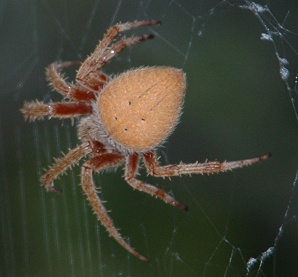 |
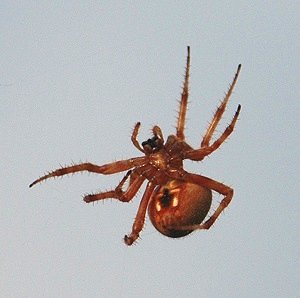 |
|
| The dorsal, or upper, surface of this orb-weaver spider was shot at dusk with a flash, revealing an abdomen like a slice of pumpkin pie, and decorative red and white striped legs. Its web ran from the pear tree to the rail fence, at the west end. | Here the same spider is shot in late afternoon in natural light, showing its ventral, or underneath side, with weird marks on the abdomen that look like the silhouette of a man's torso against light. | |
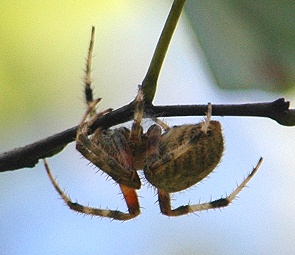 |
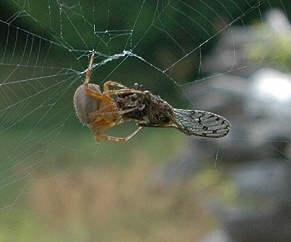 |
|
| This orb weaver was working on a web with the main line running almost twenty feet from a redbud tree to a small oak near the lily pond. On a bright morning, I couldn't tell if the furry appearance of the abdomen was brown or gray. Earlier in the year, a spider with a gray-fuzzy abdomen had spun a web from the pear tree to the rail fence. | Here that earlier spider is wrapping up a locust caught overnight. | |
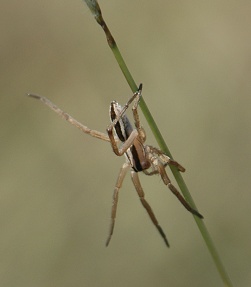 |
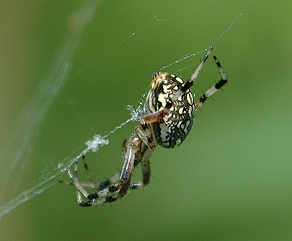 |
|
| This little striped spider, which I think is a baby 'rabid wolf' spider, was on top of a silver bluestem trying to squirt a parachute-line of silk...but when it saw me, it ran down the stalk. We have a lot of bigger version of this spider in the tall grass some years. Despite its name (or what I think is its name) it's one of the least scary of our spiders. | Another orb-weaver, this one stringing a web from a small cedar elm by the north end of the creek to the switch-grass clump nearby. I thought it was even prettier than the black and yellow Argiope I've shown pictures of before. | |
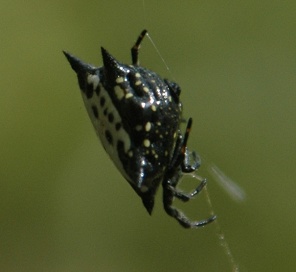 |
||
| This is the most unlikely spider on the place, and we have it in several colors--for all I know, different species. Spiny orbweavers are small spiders that look like anything but a spider...in this case, rather like a tiny black and white crab, or very large tick. They can be quite decorative, in miniature. I had much better pictures of one, but accidentally deleted the files and didn't realize it until that spider had disappeared for the winter. They build their webs only in wooded areas, on our place. | ||
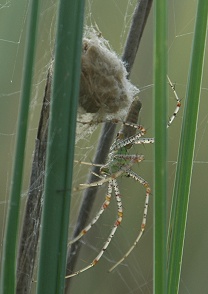 |
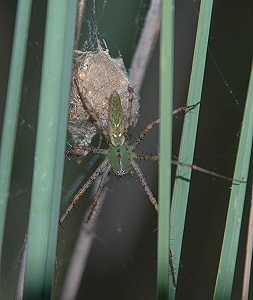
|
|
| While taking guests around the place, I spotted this spider and her nest-mass in a Lindheimer muhly. I had never seen a spider like that before...I kept thinking circus clown for the gaudy spots and stripes on the legs and body. I came back on subsequent days to photograph her, and found two more nests nearby, with very similar spiders: one on the end of a kidneywood branch, and one in an evergreen sumac leaf, which it had sewn up to make a hideyhole. This past week, I found yet another in the flowering head of a goldenrod. Although all these spiders are similar, they have different coloration and markings, except for the underlying green of the cephalothorax. | This picture was taken with flash to capture the markings of the dorsum. The only picture in my field guide for insects and spiders that is close to these is the Green Lynx Spider, Peucetia viridans, but in that picture the markings aren't the same. Does that matter? I don't know. | |
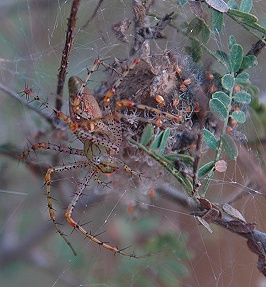 |
||
| This one, in the kidneywood, has much more orange and red, including more burgundy streaking on the cephalothorax, and burgundy, orange, and cream on the abdomen, instead of green with little burgundy streaks. This egg mass hatched first; the orange beads are tiny spiderlings. The adult spider was very protective of the nest and spiderlings, attempting to place herself between the camera lens and the nest. While watching these two nests over a period of several weeks, I noticed that the adult spiders' abdomens shrank and darkened to a leaf brown. Maybe they weren't feeding? | ||
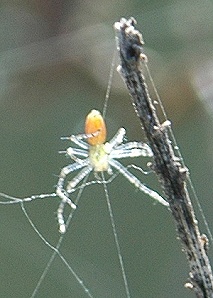 |
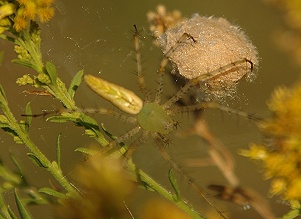 |
|
| A spiderling several days after hatching, and moments before it ejected a long thread of silk and was born away on the breeze. After hatching, the adult spider spins a nursery web where the spiderlings can run about in safety; this was the first one I saw work its way out to the edge of that web and take off. Hatchlings have excellent eyesight, and quickly skitter away to the far side of the nest mass when approached. | This one--discovered only this week, the nest mass still intact with no hatchlings--shows none of the burgundy markings of the Lindheimer and kidneywood adults, but the chevron pattern on the abdomen instead shows a gold and green pattern that works well on goldenrod. Can spiders play chameleon? I don't know that, either. | |
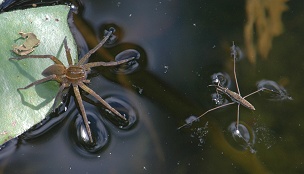 |
||
| Critical distance: this fishing spider and this water strider--both predators--know exactly how close is too close. | ||
![]()

